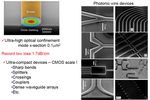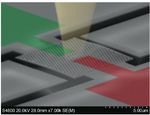Integrated Nonlinear and Quantum Photonics - Matteo Galli Matteo Galli
←
→
Page content transcription
If your browser does not render page correctly, please read the page content below
Integrated Nonlinear and Quantum
Photonics
Matteo Galli
Matteo Galli
Incontri del Martedì, Pavia 17 Aprile 2018
Congresso del Dipartimento di Fisica, 13-14 Settembre 2018Integrated Nonlinear and Quantum
Photonics
at the Physics Department
Experimental Activity
Matteo Galli and Daniele Bajoni
Micol Previde Massara, Marco Clementi, Francesco Garrisi,
Federico Sabattoli, Andrea Barone
Theoretical Activity
Marco Liscidini, Dario Gerace, Lucio AndreaniIntegrated Silicon Photonics
Motivation: Information and Communication Technology (ICT) is still based on
integrated electronic circuits, but increases in their power consumption and
heat generation are now hampering further improvements in the speed and
capacity of ICT and also hindering the realization of the ‘Green Internet’
New approach: using light (photons) to move huge amounts of data at very
high speeds with extremely low power over a thin optical fiber rather than
using electrical signals over a copper cable
Moving data with silicon and lightNonlinear Optics in Photonic Crystal Cavities
Use a photonic crystal (PhC) cavity to strongly enhance nonlinear
optical properties of host material
THG , l = 525 nm THG , l = 451 nm
1 µm
• Very efficient second- and third-harmonic generation at ultra-low
pump power (µW) in continuous-wave regime
• Realization of a bright, visible and microscopic light source in
different integrated platforms: Si, SiN, GaN, …All-optical switching (transistor) in Si PhC nanocavities
0.4
Pulsed pump laser
0.3 All-optical
Transmission
sw itching w ith
fem tojoule
0.2 pow er
0.1
0.0
148 0 148 1 148 2 148 3 148 4 148 5
W aveleng th (nm)
All-optical RAM in Si PhC nanocavities
IR control beam write
reset
storage storage
1 µm
Time (µs)Light Emission in Silicon
Use a photonic crystal (PhC) cavity to realize
an efficient and integrated light source in silicon
• Electrically driven • Emits in the telecom window
• Operates CW at room T • Is small (µm-sized)
• Exhibits a narrow linewidth • Operates at low powerIntegrated Quantum Photonics Integrated quantum photonics uses photonic integrated circuits to control photonic quantum states for applications in quantum technologies. integrated quantum photonics provides a promising approach to the miniaturization and optical scaling of optical quantum circuits. Major areas of application of integrated quantum photonics include: quantum computing, quantum communication, quantum simulation, quantum walks and quantum metrology. Quantum photonics is expected to play a central role in advancing future technologies - such as Quantum Information Processing (QIP). Photons are particularly attractive carriers of quantum information due to their low decoherence properties, light-speed transmission and ease of manipulation.
Integrated Source of Entangled Photons
Photon pair generation by
resonantly enhanced
spontaneous four wave mixing
js ji
Signal Idler
counter counter
signal Event idler
timer
D. Grassani et al., Optica 2, 88-94 (2015)ich does not take into account of eventual phase correlation. From the experimental data we
Stimulated Emission Tomography
is very close to the expected K, as in a ring resonator the phase of the BWF is predicted to
ying the spectral region in which most of the generation occurs.
nt we consider the case of CW pump, thus the generated photons are expected to be highly-
we show the corresponding measured JSD. Our pump has a coherence time of about 1 µs,
4P
predicted K = 37038. A lower bound analysis here, yielding Kbound =3.93, is too severely
P =Q
i , st
correlated, and that our technique is P s the data clearly confirms that the
ntal resolution to be used in a quantitative analysis. Yet
able to discriminate i , sp a device would generate
2 whether
ghly-correlated photon pairs. !w p
almost unentangled strongly entangled
Δλ S (pm)
D. Grassani
ured joint spectral density (JSD) for a 21 ps laser pump et al.
pulse and (b)Scientific Reports 6, 23564 (2016)
correspondingFlagship on Quantum Technologies
"With quantum theory now fully established, we are required to look at the world
in a fundamentally new way: objects can be in different states at the same time
(superposition) and can be deeply connected without any direct physical
interaction (entanglement)"
• Quantum Communication • Quantum Simulators
• Quantum Sensing • Quantum ComputersEuropean Project QUANTERA
Project CUSPIDOR - 2018-2021 (D. Gerace and M. Galli)
Development of novel single photon sources in the
telecommunication wavelength range based on group IV CMOS
• A room-temperature electrically driven silicon-germanium quantum dot
based deterministic single photon source
• A single-photon source based on the unconventional photon blockadeCUSPIDOR Consortium
JKU - Johannes Kepler Universität Linz
T. Fromherz
CIT - Cork Institute of Technology - CIT
L. O Faolain
Masaryk University
P. Klenovsky
Tyndall National Institute
S. FahyDipartimento di Eccellenza
Fisica quantistica: fondamenti e tecnologie
Potenziare la ricerca sperimentale in quantum photonics finalizzata allo
sviluppo di nuove tecnologie quantistiche
• Creazione di un laboratorio avanzato di fotonica quantistica finalizzato alla
generazione e manipolazione di stati quantistici (1.45 MEuro)
• estendere i risultati ottenuti a sistemi a più alta dimensionalità e comprendenti un
più elevato numero di particelle (hyper-entanglement, entanglement swapping)
• Sviluppo di nuove sorgenti mediante due distinti approcci, fluorescenza
parametrica e nonlinerità a singolo fotone, sfruttando confinamento della luce in
sistemi micro e nanostrutturati
• sviluppo di sorgenti nonclassiche che siano integrate, portatili, possibilmente
operanti a temperatura ambiente, e interfacciabili con le infrastrutture telecom
esistenti.
Creare un percorso didattico di laurea magistrale
• Istituzione di un nuovo curriculum di Fisica e Tecnologie Quantistiche, con
l'ampliamento dell'offerta didattica e la creazione di un nuovo laboratorio didattico di
fotonica quantisticaOngoing Collaborations
ST Microelectronics
A. Fincato
JKU - Johannes Kepler Universität Linz
T. Fromherz
School of Physics and Astronomy, University of
St. Andrews, United Kingdom
L. O Faolain
Massachussets Institue of Technology USA
N. Harris, D. Englund
University of Toronto, Canada
J. Sipe
EPFL | École polytechnique fédérale de Lausanne
C. Galland, V. SavonaYou can also read



























































